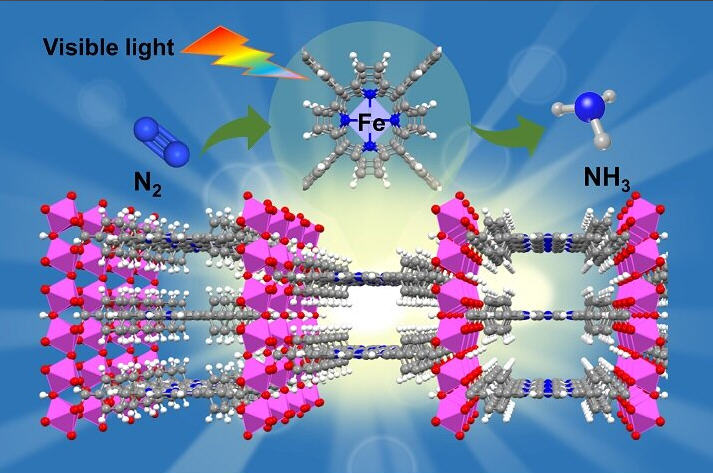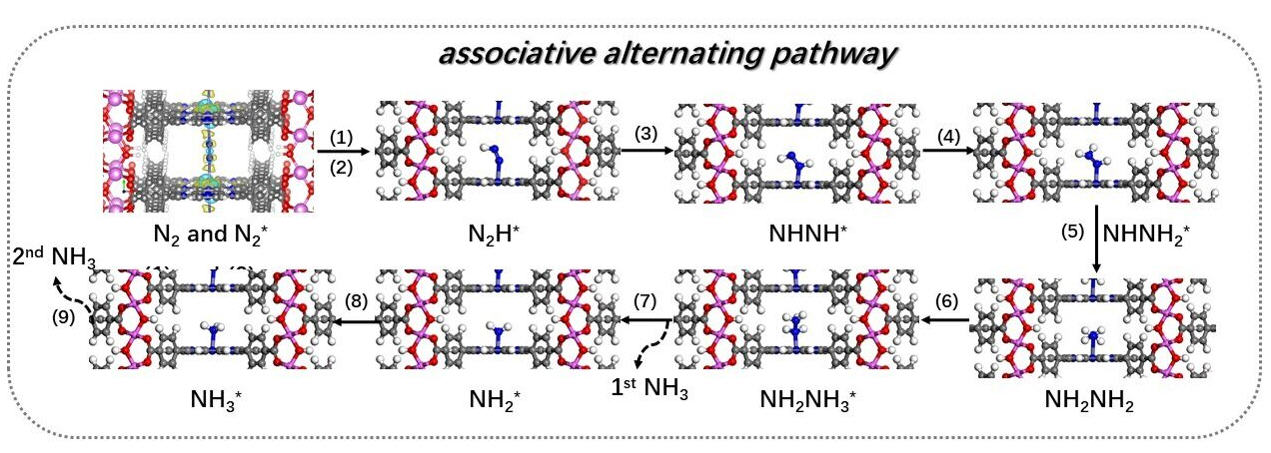博文
中澳科学家利用大气中的氮在室温下光催化制氨
 精选
精选
||
中澳科学家利用大气中的氮在室温下光催化制氨
诸平
据香港城市大学(City University of Hong Kong)2021年10月27日提供的消息,中澳科学家利用新的光催化剂在不使用化石燃料的情况下,室温即可从大气中的氮(N2)产生氨(NH3)(详见New photocatalyst produces ammonia from atmospheric nitrogen at room temperature without fossil fuels)。
氨(NH3)是肥料的主要成分,也是一种很有前途的无碳能源载体。然而,氨生产消耗了世界总能源生产的2%,每年释放5亿吨二氧化碳。由中国香港城市大学(City University of Hong Kong 简称CityU)的科学家领导的一个研究小组开发了一种新的光催化剂,可以在室温下利用阳光从大气中的氮中生成氨。这种新方法优于导致大量碳排放的传统方法。研究小组认为,这种可持续的氨生产技术将推动未来氮经济的发展。相关研究结果于2021年5月23日已经在《美国化学会纳米》(ACS Nano)杂志网站发表——Shanshan Shang, Wei Xiong, Chao Yang, Bernt Johannessen, Rugeng Liu, Hsien-Yi Hsu, Qinfen Gu, Michael K. H. Leung, Jin Shang. Atomically Dispersed Iron Metal Site in a Porphyrin-Based Metal–Organic Framework for Photocatalytic Nitrogen Fixation. ACS Nano, 2021, 15(6): 9670–9678. DOI: 10.1021/acsnano.0c10947. Publication Date:May 23, 2021. https://doi.org/10.1021/acsnano.0c10947
参与此项研究的除了来自中国香港城市大学的科学家之外,还有来自中国香港大学(University of Hong Kong)以及澳大利亚同步加速器(Australian Synchrotron, ANSTO)的科学家。
氨:一种可以取代石油和煤炭发电的新兴燃料(Ammonia: an emerging fuel that could replace petroleum and coal in generating electricity)
氨是食物和肥料的基本成分。大部分人工氨被用于生产农业肥料。氨也是一种重要的化学物质,具有广泛的工业用途,从生产洗涤剂到制冷剂。更重要的是,氨近年来引起了人们的广泛关注,因为它为燃料电池提供了氢的来源,而且它比氢更容易液化和运输。此外,氨本身可以作为发电的燃料,而不是石油和煤炭。所以生产氨的需求很大。
现行生产方法:对环境有害(Current production method: Harmful to the environment)
“固定”氮是生产氨的重要步骤。虽然大气中的80%是由氮气组成的,但这种“自由”的氮只有转化为含氮化合物才能被利用,这种转化过程被称为“固氮(nitrogen fixation)”。固氮可以自然地或人工地进行。自然固氮如豆科植物的根瘤菌就是最典型的例证。人工方法通常是指在高温高压下,以铁为催化剂,用氮气和氢气来生产氨的工业哈伯-博世工艺(industrial Haber–Bosch process)。如今,氨的生产严重依赖哈伯·博世工艺,但这是不可持续的,因为它消耗大量的化石燃料,并造成大量的二氧化碳排放,会造成严重的环境污染。
为了寻找一种可持续生产氨的方法,Michael K. H. Leung教授和尚进博士(Dr. Jin Shang音译)联合,带领他们的团队开发了一种利用水和可再生能源在环境条件下固定氮的方法。联合研究小组面临的最大挑战是制造一种催化剂,使具有挑战性的多步骤固氮反应成为可能。
新型仿生光催化剂(New biomimetic photocatalyst)
在自然界中,固氮酶(一种酶)中的铁有利于结合和激活氮,叶绿素中的卟啉(一种有机化合物)能有效地吸收阳光。受上述自然机制的启发,该团队开发了一种基于铁金属卟啉的金属有机框架(metal-organic framework简称MOFs)光催化剂(MOFs photocatalyst)。
该仿生光催化剂厚度仅为15 ~ 25 nm,在环境温度和压力下,以阳光为动力,以水为还原剂,进行人工固氮,可产生氨。该团队在这种光催化剂中使用了MOFs,因为它在表面提供了更多的活性位点,用于吸附和活化氮,从而提高了氮还原反应的效率。
该团队用这种光催化剂进行了实验,证明可以产生氨。Michael K. H. Leung教授说:“我们开发了一种新的光催化剂,在基于MOFs的光催化剂类别中,能够实现最佳的光催化固氮性能。它在MOFs中表现出最高的氨产率和最佳的水解稳定性(hydrolytic stability)。”良好的水解稳定性意味着该光催化剂可以反复使用。
通过这项研究,该团队探索了在他们的仿生光催化剂上进行光催化氮还原反应。尚进博士指出,从这项工作中获得的新知识将指导下一代MOFs基光催化剂的合理设计。他相信他们的发现将释放出开发各种卟啉基MOFs作为各种能源和环境应用的光催化剂的潜力。
该团队希望这项开创性的研究能够启发催化领域的科学家和工程师探索和开发基于MOFs的仿生光催化剂,用于催化其他环境温度和压力下的化学反应,而不仅仅局限于人工固氮。
Michael K. H. Leung教授总结说:“通过无化石燃料过程生产能源和商品化学品是实现碳中和的理想方法。该研究开发出了利用阳光从大气中的氮和水中生产氨的技术,我们以可持续的方式获得无碳能源。”该团队相信他们的发现将有助于缓解日益紧迫的能源危机和环境问题。
上述介绍,仅供参考。欲了解更多信息,敬请注意浏览原文或者相关报道。
The rational design of photocatalysts for efficient nitrogen (N2) fixation at ambient conditions is important for revolutionizing ammonia production and quite challenging because the great difficulty lies in the adsorption and activation of the inert N2. Inspired by a biological molecule, chlorophyll, featuring a porphyrin structure as the photosensitizer and enzyme nitrogenase featuring an iron (Fe) atom as a favorable binding site for N2via π-backbonding, here we developed a porphyrin-based metal–organic framework (PMOF) with Fe as the active center as an artificial photocatalyst for N2 reduction reaction (NRR) under ambient conditions. The PMOF features aluminum (Al) as metal node imparting high stability and Fe incorporated and atomically dispersed by residing at each porphyrin ring promoting the adsorption and the activation of N2, termed Al-PMOF(Fe). Compared with the pristine Al-PMOF, Al-PMOF(Fe) exhibits a substantial enhancement in NH3 yield (635 μg g–1cat.) and production rate (127 μg h–1 g–1cat.) of 82% and 50%, respectively, on par with the best-performing MOF-based NRR catalysts. Three cycles of photocatalytic NRR experimental results corroborate a stable photocatalytic activity of Al-PMOF(Fe). The combined experimental and theoretical results reveal that the Fe–N site in Al-PMOF(Fe) is the active photocatalytic center that can mitigate the difficulty of the rate-determining step in photocatalytic NRR. The possible reaction pathways of NRR on Al-PMOF(Fe) were established. Our study of porphyrin-based MOF for the photocatalytic NRR will provide insight into the rational design of catalysts for artificial photosynthesis.
https://blog.sciencenet.cn/blog-212210-1309818.html
上一篇:张勤海的部分研究论文摘引
下一篇:中国团队已经在量子计算机领域取得了领先地位


